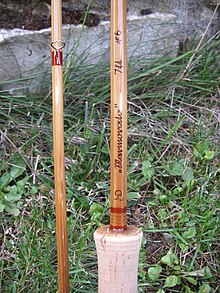Split
Under split cane is meant fishing rods from the natural material of bamboo , which is still in fly fishing can be used.
Bamboo from the Chinese province of Tonkin is preferred for production. In particular, the bamboo Arundinaria amabilis , which is now called Pseudosasa amabilis , is suitable for this.
In one of the first steps, the bamboo is split lengthways and divided into individual splices. The blank (the bare rod without rings and the like) is usually made of six splices that are permanently glued together. There are variants made up of four, others made up of up to 18 individual splices. The individual splices are brought into the desired shape with the help of a hand plane, the shape being set with a dial gauge .
Compared to fishing rods made of modern carbon fiber reinforced plastic (CFRP, “carbon fiber”), split rods have the advantage that they are not prone to breakage when hit. A split rod does not have to be heavier than a carbon fiber rod, the hollow splicing means that low weights can also be achieved here. The prejudice that a split-pin needs a lot of care is also incorrect; it is simply wiped off after fishing and kept dry. For longer periods of time, split rods should be kept hanging in the sheath or standing in the open rod tube. Split rods don't have to be more expensive than carbon fiber rods.
literature
- Wayne Cattanach: Handcrafting Bamboo Fly Rods
- Hoagy B. Carmichael: A Master's Guide to Building a Bamboo Fly Rod
- George E. Maurer, Bernard P. Elser: Fundamentals of Building a Bamboo Fly-Rod
- Rolf Baginski: Spliced - Noble rods made of bamboo
- Harald Langer: Split fly rods - appearance or reality
- Harald Langer: Queen of the fly rods
- Stefan Grau: "Self-made split fishing rods" (self-published in 2002)

